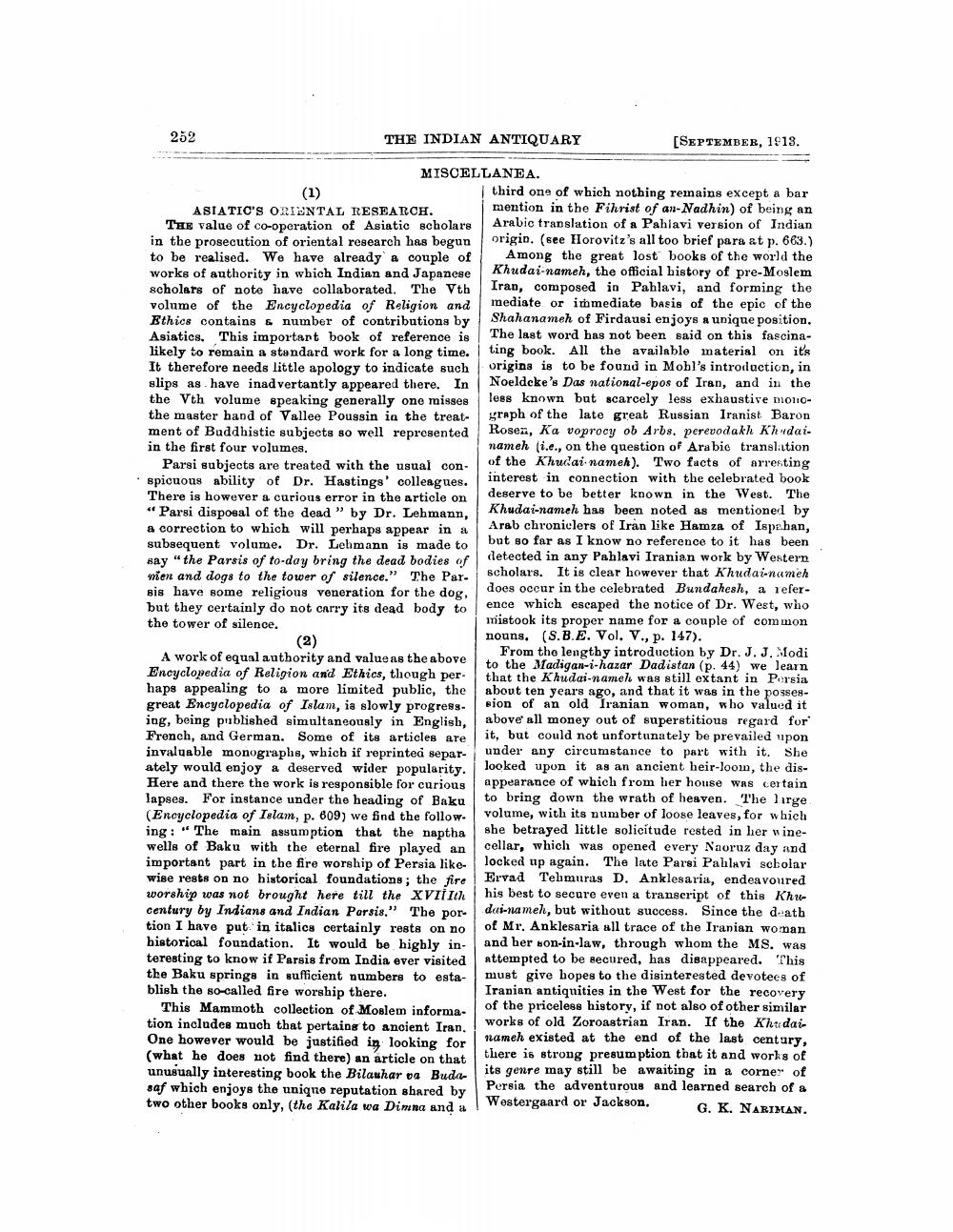________________
252
THE INDIAN ANTIQUARY
MISCELLANEA.
(1)
ASIATIC'S ORIENTAL RESEARCH.
THE value of co-operation of Asiatic scholars in the prosecution of oriental research has begun to be realised. We have already a couple of works of authority in which Indian and Japanese scholars of note have collaborated. The Vth volume of the Encyclopedia of Religion and Ethics contains & number of contributions by Asiatics. This important book of reference is likely to remain a standard work for a long time. It therefore needs little apology to indicate such slips as have inadvertantly appeared there. In the Vth volume speaking generally one misses the master hand of Vallee Poussin in the treatment of Buddhistic subjects so well represented in the first four volumes.
Parsi subjects are treated with the usual conspicuous ability of Dr. Hastings' colleagues. There is however a curious error in the article on "Parsi disposal of the dead" by Dr. Lehmann, a correction to which will perhaps appear in a subsequent volume. Dr. Lehmann is made to say "the Parsis of to-day bring the dead bodies of men and dogs to the tower of silence." The Parsis have some religious veneration for the dog, but they certainly do not carry its dead body to the tower of silence.
(2)
A work of equal authority and value as the above Encyclopedia of Religion and Ethics, though per haps appealing to a more limited public, the great Encyclopedia of Islam, ia slowly progressing, being published simultaneously in English, French, and German. Some of its articles are invaluable monographs, which if reprinted separately would enjoy a deserved wider popularity. Here and there the work is responsible for curious lapses. For instance under the heading of Baku (Encyclopedia of Islam, p. 609) we find the follow ing: "The main assumption that the naptha wells of Baku with the eternal fire played an important part in the fire worship of Persia likewise rests on no historical foundations; the fire worship was not brought here till the XVIIIth century by Indians and Indian Parsis." The portion I have put in italics certainly rests on no historical foundation. It would be highly interesting to know if Parsis from India ever visited the Baku springs in sufficient numbers to establish the so-called fire worship there.
This Mammoth collection of Moslem information includes much that pertains to ancient Iran. One however would be justified in looking for (what he does not find there) an article on that unusually interesting book the Bilauhar va Budasaf which enjoys the unique reputation shared by two other books only, (the Kalila wa Dimna and a
[SEPTEMBER, 1913.
third one of which nothing remains except a bar mention in the Fihrist of an-Nadhin) of being an Arabic translation of a Pahlavi version of Indian origin. (see Horovitz's all too brief para at p. 663.)
Among the great lost books of the world the Khudai-nameh, the official history of pre-Moslem Iran, composed in Pahlavi, and forming the mediate or immediate basis of the epic of the Shahanameh of Firdausi enjoys a unique position. The last word has not been said on this fascinating book. All the available material on it's origina is to be found in Mohl's introduction, in Noeldeke's Das national-epos of Iran, and in the less known but scarcely less exhaustive monograph of the late great Russian Iranist Baron Rosen, Ka voprocy ob Arbs. perevodakh Khudainameh (i.e., on the question of Arabic translation of the Khudai nameh). Two facts of arresting interest in connection with the celebrated book deserve to be better known in the West. The Khudai-nameh has been noted as mentioned by Arab chroniclers of Iran like Hamza of Ispahan, but so far as I know no reference to it has been
detected in any Pahlavi Iranian work by Western
scholars. It is clear however that Khudai-nameh
does occur in the celebrated Bundahesh, a reference which escaped the notice of Dr. West, who mistook its proper name for a couple of common nouns. (S.B.E. Vol. V., p. 147).
From the lengthy introduction by Dr. J. J. Modi to the Madigan-i-hazar Dadistan (p. 44) we learn that the Khudai-namel was still extant in Persia about ten years ago, and that it was in the possession of an old Iranian woman, who valued it above all money out of superstitious regard for it, but could not unfortunately be prevailed upon under any circumstance to part with it. She looked upon it as an ancient heir-loom, the disappearance of which from her house was certain to bring down the wrath of heaven. The large volume, with its number of loose leaves, for which she betrayed little solicitude rested in her winecellar, which was opened every Naoruz day and locked up again. The late Parsi Pahlavi scholar Ervad Tehmuras D. Anklesaria, endeavoured his best to secure even a transcript of this Khu dai-nameh, but without success. Since the death of Mr. Anklesaria all trace of the Iranian woman and her son-in-law, through whom the MS. was attempted to be secured, has disappeared. This must give hopes to the disinterested devotees of Iranian antiquities in the West for the recovery of the priceless history, if not also of other similar works of old Zoroastrian Iran. If the Khudainameh existed at the end of the last century, there is strong presumption that it and works of its genre may still be awaiting in a corner of Persia the adventurous and learned search of a Westergaard or Jackson. G. K. NARIMAN.




